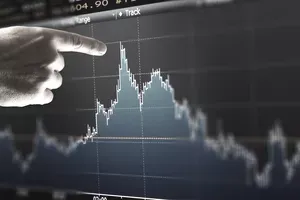Bar charts are one of the most popular trading chart types. They provide a lot of information that the day trader can use when making trading decisions and are relatively easy to read and interpret.
Bar charts consist of an opening foot—facing left—a vertical line, and a closing foot—facing right. Each bar includes the open, high, low, and close price that occurred during a specific interval, set by the
trader.For example, if a day trader opts to view a 1-minute bar chart, then a new bar will form every minute, and each bar will show the open, high, low, and close price for each minute. The interval can also be something other than time, such as a specific number of transactions. When a chart displays transactions it is called a tick chart. Here, a new bar forms when a certain number of transactions have occurred for the stock or asset being charted.
Bar charts also show the direction of movement—upward or downward—in the price, as well as how far the price moved during the bar. Day traders can then assess how the price is moving based on the bar chart. When a trader makes trading decisions based on those price bars, they are called price action traders.
How to Read a Bar Chart
Bar charts are often called OHLC Bar charts, as well as HLC Bar charts. The former is more popular and includes information on the open (O), high (H), low (L), and close (C) price. Whereas the HLC chart just includes information on high, low, and close.
Open
The open is the first price traded during the bar and is indicated by the horizontal foot on the left side of the bar.
High
The high is the highest price traded during the bar and is indicated by the top of the vertical bar.
Low
The low is the lowest price traded during the bar and is indicated by the bottom of the vertical bar.
Close
The close is the last price traded during the bar and is indicated by the horizontal foot on the right side of the bar.
Direction and Range
The direction the price has moved during the bar is indicated by the locations of the opening and closing feet. If the closing foot is above the opening foot then the price made upward progress during the bar. If the closing foot is below the opening foot then the price made downward progress during the bar.
The range of the bar is indicated by the locations of the top and bottom of the vertical bar. The range is calculated by subtracting the low from the high (Range of Bar = High - Low).
Final Word
It takes a bit of practice to get used to reading a bar chart, especially when the price is moving very quickly. Remember the open is always on the left, and close always appears on the right (like how you read: the right to left because the open always comes before the close). The vertical part of the bar represents how high and low the price went during the interval of the bar.
A bar chart can also typically include volume—how many shares, forex lots, or futures contracts are changing hands on each bar. Therefore, it is also recommended you understand buying and selling volume when reading a bar chart.
Other chart types include Renko, candlestick, and Heikin Ashi charts.



